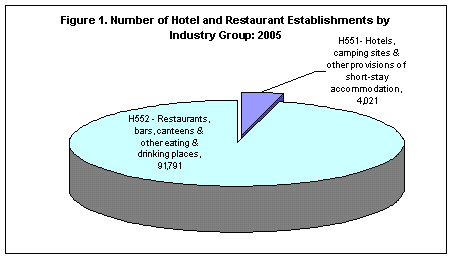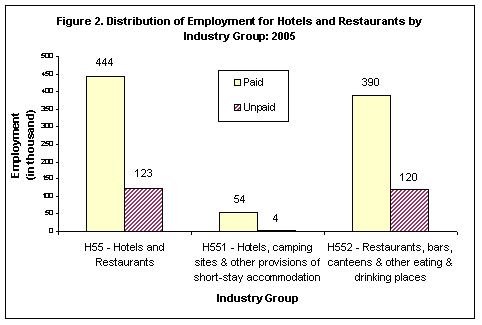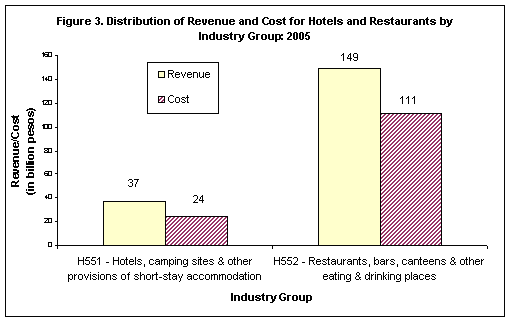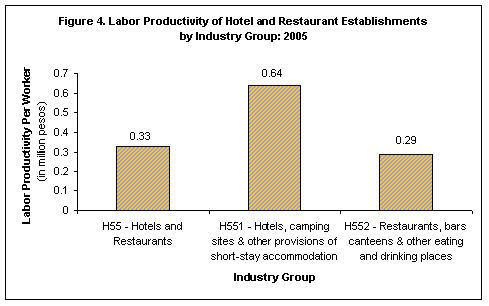Majority of establishments are Restaurants, bars, canteens & other eating and drinking places
- The 2005 Annual Survey of Philippine Business and Industry (ASPBI) covered a total of 95,812 hotel and restaurant establishments. Of the total, 92,198 establishments or 96.2 percent had an average total employment (ATE) of less than 20, while only 3,614 establishments or 3.8 percent had ATE of more than 20. (See Tables 1 to 3.)
- Restaurants, bars, canteens & other eating & drinking places (PSIC H552) comprised the biggest number of establishments in the hotels and restaurants sector with 91,791 or 95.8 percent. The remaining 4,021 establishments (4.2 percent) were hotels, camping sites and other provisions of short-stay accommodation (PSIC H551). Figure 1 shows the distribution of hotels and restaurants by industry group.

Restaurants, bars, canteens & other eating and drinking places employ the most number of workers
- Total employment generated in 2005 by hotels and restaurants reached 567,624 workers. Of this, 444,232 or 78.3 percent were paid employees while the rest were working owners and unpaid workers. (See Figure 2.)
- Restaurants, bars, canteens and other eating and drinking places (PSIC H552) employed the most number of workers with 510,038 or 89.9 percent. The rest were hired by establishments engaged in hotels, camping sites and other provisions of short-stay accommodation (H551) with 57,586 or 10.1 percent.

Average monthly compensation per paid employee is Php 5,348
- Compensation paid by hotel and restaurant establishments amounted to Php 28.5 billion which was equivalent to an average monthly compensation of Php 5,348 per paid employee.
- Employees in hotels, camping sites and other provisions of short-stay accommodation received the highest average monthly pay of Php 11,683. Workers engaged in restaurants, bars, canteens and other eating and drinking places received Php 4,474 per month.
Restaurants, bars, canteens & other eating and drinking places are top earners and spenders
- Total revenue earned by the sector in 2005 amounted to Php 186.0 billion. Restaurants, bars, canteens and other eating and drinking places generated the highest revenue amounting to Php 149.1 billion or 80.1 percent of the total revenue. The remaining amount was posted by hotels, camping sites and other provisions of short-stay accommodation with Php 36.9 billion or 19.9 percent. (See Figure 3.)

- Total cost incurred by hotels and restaurants excluding compensation for 2005 reached Php 135.2 billion. Restaurants, bars, canteens and other eating & drinking places spent the highest cost amounting to Php 111.0 billion or (82.1%) of the total.
Gross additions to fixed assets reach Php 7.5 billion
- Gross additions to fixed assets of hotels and restaurants reached Php 7.5 billion. Hotels, camping sites and other provisions of short-stay accommodation recorded the highest acquisition expense at Php 5.2 billion (69.0%).
Total change in inventories amounts to Php 838.3 million
- Change in inventories reported by the sector amounted to Php 838.3 million. Restaurants, bars, canteens and other eating & drinking places recorded the highest change in inventories with Php 692.5 million or 82.6 percent of the total.
Labor productivity per worker is Php 0.33 million
- Revenue per worker, a measure of labor productivity was valued at Php 0.33 million. The highest labor productivity at Php 0.64 million was attained by hotels, camping sites and other provisions of short-stay accommodation. Restaurants, bars, canteens & other eating and drinking places was valued at Php 0.29 million. Figure 4 shows labor productivity by industry group. (See also Tables R1 to R3 for other economic indicators.)

TECHNICAL NOTES
Scope and Coverage
The 2005 Annual Survey of Philippine Business and Industry (ASPBI) is a continuing activity of the National Statistics Office which aimed to collect information on the structure and trends of economic activities in the entire country for the year 2005. Covered were establishments engaged in economic activities as defined under the amended 1994 Philippine Standard Industrial Classification (PSIC). These establishments were classified into 14 sectors, one of which is hotels and restaurants (Sector H). This sector is composed of establishments engaged in two (2) industry groups: hotels, camping sites and other provisions of short-stay accommodation (H551), and restaurants, bars, canteens and other eating and drinking places (H552).
All hotel and restaurant establishments nationwide with average total employment (ATE) of 100 and over were covered on a 100 percent basis and those with ATE of less than 100 were selected using simple random sampling.
Response Rate
A total of 1,229 or 95.05% responded out of the 1,293 samples drawn for the sector but the effective response rate is 74.40% only.
Concepts and Definition of Terms
Establishment - an economic unit, which engages under a single ownership or control, i.e. under a single legal entity, in one, or predominantly one kind of economic activity at a single fixed location.
Economic activity or business - is the activity of the establishment as classified under the1994 Philippine Standard Industrial Classification (PSIC). The main activity refers to the activity that contributes the biggest or major portion of the gross income or revenue of the establishment.
Total Employment - is the number of persons who worked in or for the establishment as of November 15, 2005.
Paid employees - are all persons working in the establishments receiving pay as well as those working away from the establishment when paid by and under the control of the establishment. Included are persons working as full-time or part-time and those employees on sick leave, paid vacation or holiday. Excluded are consultants, home workers and workers receiving commission only.
Unpaid workers - include working owners who do not receive regular pay, apprentices and learners without regular pay, and persons working without regular pay for at least one third of the working time normal to the establishment.
Salaries and wages - are payments in cash or in kind, prior to deduction for employees contribution to SSS/GSIS, withholding tax, etc. Included are total basic pay, vacation, sick, maternity leave pay, overtime pay, and other benefits.
Revenue - refers to cash received and receivables for goods sold and services rendered.
Cost - refers to all expenses excluding compensation incurred during the year whether paid or payable. Valuation should be at market price including taxes and other charges, net of discounts, rebates, returns and allowances. Goods received from and services rendered by other establishment of the same enterprise are valued as though purchased.
Gross additions to fixed assets - refer to the cost of acquisition of fixed assets acquired in 2005 less the value of sales of fixed assets during the year.
Fixed assets - are physical assets expected to have productive life of more than one year and intended for use and/or being used by the establishment. Included are land, buildings, fixtures, machinery, tool, furniture, office equipment, vehicles, and the like.
Subsidies - are special grants in the form of financial assistance or tax exemption or tax privilege given by the government to develop an industry or production and to protect it against competition.
Inventories - refer to stocks of goods owned by or under the control of the establishment as of a fixed date, regardless of where the stocks are located. Valuation should be at current replacement cost in purchasers price at the indicated dates. Replacement cost is the cost of an item in terms of its present price rather than its original price.
Change in Inventories - as a derived indicator is computed as the value of ending inventory less the value of beginning inventory.
Value Added - is the total revenue plus capital expenditures (own account) plus change in inventories less total cost (net of indirect taxes, interest, bad and doubtful debts and depreciation).
Source: National Statistics Office
Manila, Philippines
